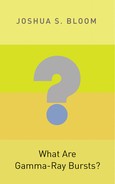Book Description
Gamma-ray bursts are the brightest--and, until recently, among the least understood--cosmic events in the universe. Discovered by chance during the cold war, these evanescent high-energy explosions confounded astronomers for decades. But a rapid series of startling breakthroughs beginning in 1997 revealed that the majority of gamma-ray bursts are caused by the explosions of young and massive stars in the vast star-forming cauldrons of distant galaxies. New findings also point to very different origins for some events, serving to complicate but enrich our understanding of the exotic and violent universe. What Are Gamma-Ray Bursts? is a succinct introduction to this fast-growing subject, written by an astrophysicist who is at the forefront of today's research into these incredible cosmic phenomena.
Joshua Bloom gives readers a concise and accessible overview of gamma-ray bursts and the theoretical framework that physicists have developed to make sense of complex observations across the electromagnetic spectrum. He traces the history of remarkable discoveries that led to our current understanding of gamma-ray bursts, and reveals the decisive role these phenomena could play in the grand pursuits of twenty-first century astrophysics, from studying gravity waves and unveiling the growth of stars and galaxies after the big bang to surmising the ultimate fate of the universe itself.
What Are Gamma-Ray Bursts? is an essential primer to this exciting frontier of scientific inquiry, and a must-read for anyone seeking to keep pace with cutting-edge developments in physics today.
Table of Contents
- Cover
- Title
- Copyright
- Dedication
- Contents
- Preface
- 1: Introduction
- 1.1 Serendipity during the Cold War
- 1.2 A New Field Begins
- 1.3 Precise Localizations and the Search for Counterparts
- 1.4 The March 5th Event and Soft-Gamma Ray Repeaters
- 1.5 BATSE and the Great Debate
- 1.6 The Afterglow Era Begins
- 1.7 Progenitors and Diversity
- 1.8 Gamma-Ray Bursts in a Universal Context
- 2: Into the Belly of the Beast
- 3: Afterglows
- 4: The Events in Context
- 5: The Progenitors of Gamma-Ray Bursts
- 6: Gamma-Ray Bursts as Probes of the Universe
- 6.1 Studies of Gas, Dust, and Galaxies
- 6.2 The History of Star Formation
- 6.3 Cosmic Dawn: Measuring Reionization and the First Objects in the Universe
- 6.4 Neutrinos, Gravitational Waves, and Cosmic Rays
- 6.5 Quantum Gravity and the Expansion of the Universe
- 6.6 The Future of Gamma-Ray Bursts: At the Nexus of Physical and Astrophysical Inquiry
- Notes
- Suggestions for Further Reading
- Glossary
- Index
